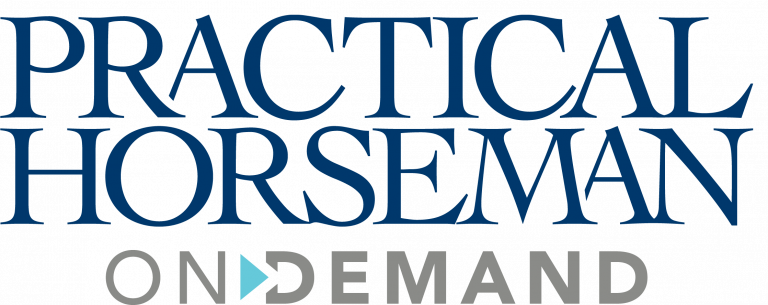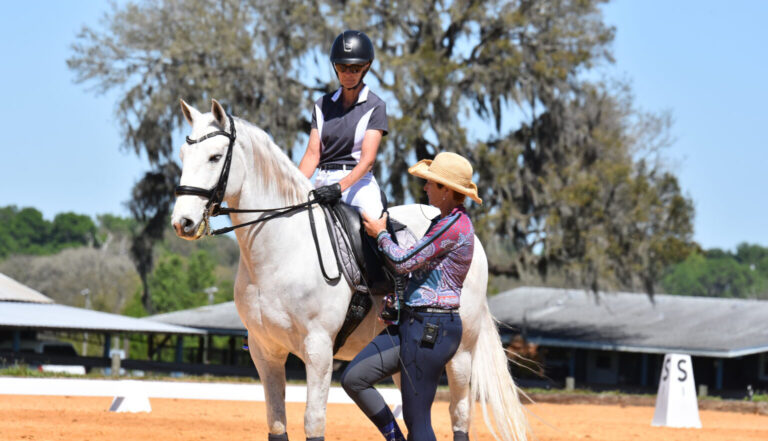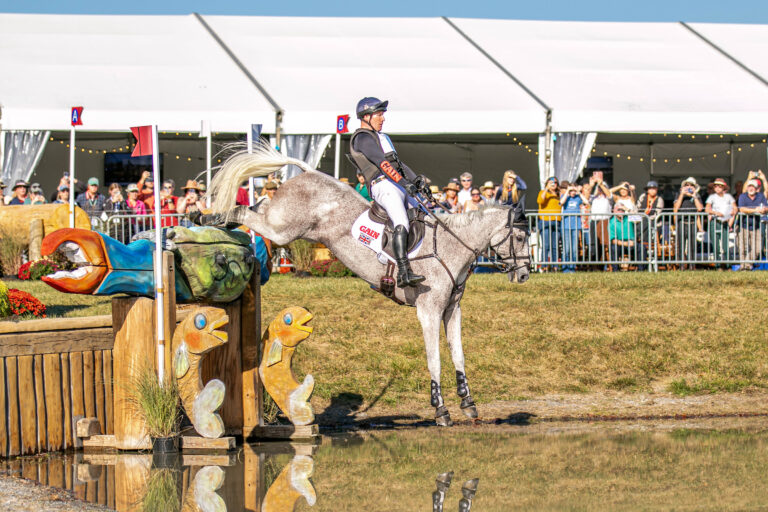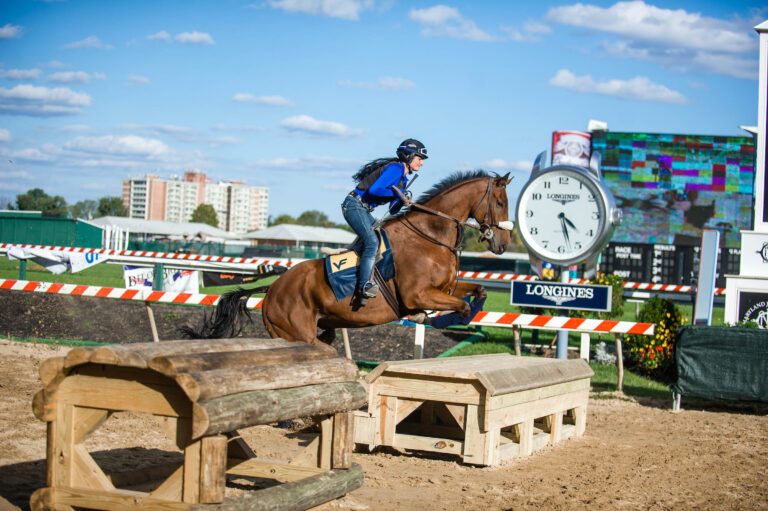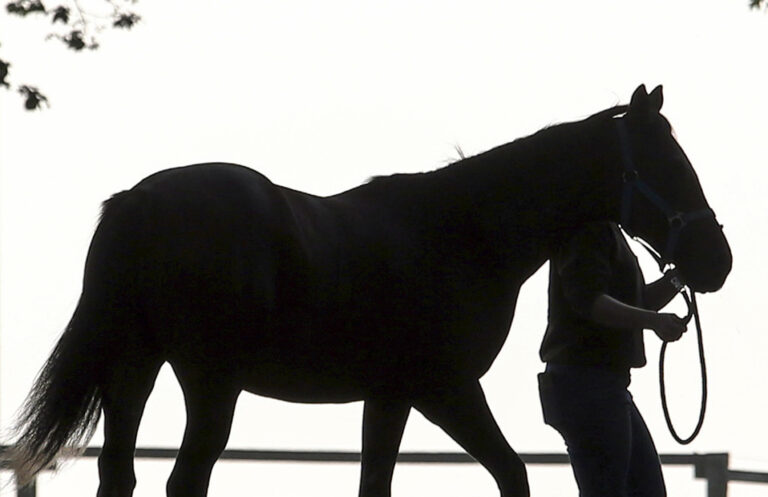To find the right amount of aids for your horse, five-star eventer and Pan American Games team silver medalist Sharon White says it’s all about knowing your horse. In this lesson from her video series on EQUESTRIAN+, White coaches student Leah and her gelding “Frosty” in a stadium-jumping lesson to help her become more confident with her aids on course.
The horse-and-rider pair work through canter poles on a curve, single fences and a gymnastic bounce line with raised rails between the fences to focus on Frosty’s footwork and help create the powerful canter needed for bigger fences. White also stresses preparing earlier before a jump and not being too quick to turn your head to the next fence.
Know Your Horse
“When it comes to finding the right aids for your horse, it’s all about knowing your horse. Not all horses need a supportive leg, but a lot of do. You have to develop the awareness to know if you need more or less leg. More or less rein? Do you need to be in a full seat or half seat? And this applies across the board with everything. Does your horse need more or less grain? Does he need more or less exercise? Does he need more days off or more days working? Each horse has a way they perform their best. So, it’s our job to figure those things out.
“Age also matters when it comes to your aids. With baby horses you might need a lot of leg because they don’t know what they’re doing yet. With your particular horse, he knows what he’s doing and he’s pretty relaxed about it, so he likely needs a more supportive leg. When your leg is there to support, he needs to learn that it doesn’t mean go faster or to lengthen his stride; it’s just there to maintain the power.
Cantering ground poles on a slight curve in three, flowing strides.
“To practice adjusting your horse’s stride with your aids, we’re going to start by cantering two ground rails positioned on a curve. We’ll start off the left, and I want you to focus on getting a good quality canter with a supportive leg and we’ll see how many strides he naturally gets on his own.
“He naturally got a nice, flowing three. Next, I want you to shorten the stride to get four strides. Get it done early, but let him use his neck and be patient.
Cantering the ground poles in a collected four strides.
“Now, cross the arena to change directions and we’ll again do it in three strides and then in four off the right. Going this direction, he needs more leg support, especially with your inside leg. This time, he ran through the three, so come again and whoa so he doesn’t run and support with your leg on the backside.
“Next, let’s hop over the vertical to the green-and-white oxer across the diagonal. Be careful not to rush. You got a slightly deep distance over the vertical and had to twist a tiny bit. He had to use his gaskins and stifles a little more, but you were so calm and relaxed about it. That was a quality deep distance.”
Riding a quality deep distance to a vertical followed by an oxer across the diagonal.
Bounce Exercise for His Footwork & Your Position
“Now, we’re going to play through this bounce exercise to provide Frosty with a little footwork and to give you a chance to focus on your position. Your other job is to keep him straight and let him see where he’s going. This exercise naturally teaches him to compress, which you can use to your advantage because it gives you power in the canter.
Over-riding the bounce grid to the oxer.
“The first time you overdid it, which isn’t shocking. We can be overachievers because we care too much. No big deal. Go again without overdoing it. But now you’re job is also to not underdo it. You have to find that sweet spot right in the middle. Keep your eye up and focus on feeling the straightness and that uphill balance.”
Ideal ride of bounce grid to the oxer.
Learn How to ‘Own It’ Through Repetition
“Don’t turn your head too soon to the next fence. That’s not it. You might as well have four years to get there. When you turn your head that far right in the air over the first fence, you’ve forgotten an entire part and have just zoomed from that jump to this one without doing anything in between.
“In the beginning, of course, you have to teach yourself to look toward the next fence. And a lot of times on cross country, you have to turn your head to get there because there might be something else to do right away. But with show jumping it’s slightly different. Yes, you can turn your head and look but you can’t abandon large areas of space where you need to ride your horse, because he doesn’t just do it for you. He’d be happy to cut through a turn because it’s easier than having to push through his hindquarters to create and maintain impulsion.
“You have to learn to own it. If you don’t own it, repetition is key. Just do it again and again until you develop that feel. We all go through patterns of getting it wrong and then you obsess over being perfect and start doing too much in the wrong places. Sometimes horses need us to do more. Sometimes they need us to do less.
Use repetition to learn how to own it.
“Sometimes I need motivation and sometimes less. Sometimes I need a glass of wine. Other times, I need a cup of coffee. It just depends on what the moment calls for. In riding you might have to go back and forth being passive and more assertive.”
For More:
- For more on Sharon White and for her top tips and eventing advice, click here.
- You can find additional tips to sharpen up your show-jumping skills here.
About Sharon White
Five-star eventer Sharon White was short-listed for the 2007 US Pan American team and selected for US Equestrian Team Developing Rider training sessions in 1996 and 1999-2003. She has trained with top riders and coaches such as Bruce and Buck Davidson, Torrance Watkins, Jim Wofford, Jules Nyssen and Mary Flood. Based in Summit Point, West Virginia, Sharon and her parents, George and Carol White, co-own Last Frontier Farm, a full-service training and breeding facility.




